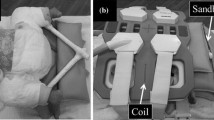Abstract
Purpose
Non-concentric reduction of the femoral head within the acetabulum is detrimental to its delicate cartilaginous structure and may result in a growth disturbance. Successful relocation of the dislocated femoral head depends on subtle clinical findings and radiography. The combination of a dislocated femoral head and a severely dysplastic acetabulum can result in a clinical examination that is unhelpful in confirming reduction under anaesthesia. In cases where uncertainty existed regarding head reduction in a spica cast, we performed axial short inversion time inversion recovery (STIR) and axial proton density magnetic resonance imaging (MRI) scans. We retrospectively reviewed the efficiency and accuracy of MRI in confirming femoral head location after closed reduction and spica application in eight children.
Methods
One hundred and fifty-three cases of developmental dysplasia were treated with examination under anaesthesia and spica application in our unit over a 3-year period. Eight cases where MRI scanning was performed were identified. Before application of the spica cast, we used radiographic screening to assess the stability of the reduction. Absence of the ossific nucleus within the femoral head made confirmation of the location with the image intensifier unreliable. To confirm concentric femoral head location after closed reduction and spica application, we performed an MRI scan in the immediate post-anaesthesia period.
Results
All scans were performed within 30 min of application of the spica, and the average time for each scan was 5 min. All eight children who had MRI post-application of the spica had concentric reduction of the femoral head. MRI allowed three-dimensional appreciation of the acetabulum and femoral head. Use of the axial STIR images allows accurate assessment of the cartilaginous ossific nucleus. All patients were discharged the same afternoon and followed up as outpatients. No patient in our group required contrast arthrography.
Conclusion
While not indicated in all cases of femoral head dislocation, MRI is useful to confirm concentric reduction of the femoral head in a dysplastic acetabulum when examination under anaesthesia and radiographic screening have been uncertain. In our series, 1 in 20 cases needed MRI. This is a reliable, non-invasive method confirming definite reduction of the femoral head prior to discharge in all of our patients. In this initial series, all patients had axial and coronal STIR and proton density MRI. We now only use axial STIR images because they provide adequate information regarding the position of the femoral head relative to the acetabulum.



Similar content being viewed by others
References
Weinstein SL (1996) Developmental hip dysplasia and dislocation. In: Morrissey RT, Weinstein SL (eds) Pediatric orthopaedics, 4th edn. Lippincott-Raven, Philadelphia, pp 903–950
Duffy CM, Taylor FN, Coleman L, Graham HK, Nattrass GR (2002) Magnetic resonance imaging evaluation of surgical management in developmental dysplasia of the hip in childhood. J Pediatr Orthop 22:92–100. doi:10.1097/00004694-200201000-00020
Laor T, Roy DR, Mehlman CT (2000) Limited magnetic resonance imaging examination after surgical reduction of developmental dysplasia of the hip. J Pediatr Orthop 20:572–574. doi:10.1097/00004694-200009000-00005
Johnson ND, Wood BP, Noh KS, Jackman KV, Westesson PL, Katzberg RW (1989) MR imaging anatomy of the infant hip. AJR Am J Roentgenol 153:127–133
Smith BG, Millis MB, Hey LA, Jaramillo D, Kasser JR (1997) Postreduction computed tomography in developmental dislocation of the hip: part II: predictive value for outcome. J Pediatr Orthop 17:631–636. doi:10.1097/00004694-199709000-00011
Westhoff B, Wild A, Seller K, Krauspe R (2003) Magnetic resonance imaging after reduction for congenital dislocation of the hip. Arch Orthop Trauma Surg 123:289–292
Fisher R, O’Brien TS, Davis KM (1991) Magnetic resonance imaging in congenital dysplasia of the hip. J Pediatr Orthop 11:617–622
McNally EG, Tasker A, Benson MK (1997) MRI after operative reduction for developmental dysplasia of the hip. J Bone Joint Surg Br 79:724–726. doi:10.1302/0301-620X.79B5.7772
Aoki K, Mitani S, Asaumi K, Akazawa H, Inoue H (1999) Utility of MRI in detecting obstacles to reduction in developmental dysplasia of the hip: comparison with two-directional arthrography and correlation with intraoperative findings. Orthop Sci 4:255–263. doi:10.1007/s007760050101
Bos CFA, Bloem JL, Obermann WR, Rozing PM (1988) Magnetic resonance imaging in congenital dislocation of the hip. J Bone Joint Surg Br 70:174–178
Guidera KJ, Einbecker ME, Berman CG, Ogden JA, Arrington JA, Murtagh R (1990) Magnetic resonance imaging evaluation of congenital dislocation of the hips. Clin Orthop Relat Res 261:96–101
Tennant S, Kinmont C, Lamb G, Gedroyc W, Hunt DM (1999) The use of dynamic interventional MRI in developmental dysplasia of the hip. J Bone Joint Surg Br 81:392–397. doi:10.1302/0301-620X.81B3.8964
Jaramillo D, Villegas-Medina O, Laor T, Shapiro F, Millis MB (1998) Gadolinium-enhanced MR imaging of pediatric patients after reduction of dysplastic hips: assessment of femoral head position, factors impeding reduction, and femoral head ischemia. AJR Am J Roentgenol 170:1633–1637
Acknowledgments
I would like to thank R. O. Connor and all the staff in Department of Paediatric Radiology, Temple Street, Dublin for helping with the preparation of this article.
Author information
Authors and Affiliations
Corresponding author
About this article
Cite this article
Conroy, E., Sproule, J., Timlin, M. et al. Axial STIR MRI: a faster method for confirming femoral head reduction in DDH. J Child Orthop 3, 223–227 (2009). https://doi.org/10.1007/s11832-009-0170-0
Received:
Accepted:
Published:
Issue Date:
DOI: https://doi.org/10.1007/s11832-009-0170-0




